KFC's Service Marketing and Relationship Dynamics: An Analysis
VerifiedAdded on 2023/06/05
|11
|2711
|200
Report
AI Summary
This report provides a detailed analysis of KFC's service and relationship marketing strategies, differentiating between front stage (customer segments, value proposition, channels, and customer relationships) and backstage (key activities, key resources, key partners, and cost structure) operations. It examines how KFC tailors its customer segmentation to local markets, develops value propositions based on qualitative and quantitative factors, and manages channels for awareness, evaluation, purchase, delivery, and after-sales service. The report also discusses the managerial implications of KFC's approach, emphasizing the importance of intangible elements, customer interaction, employee training, and time management in delivering quality service and enhancing customer satisfaction. The analysis highlights how KFC's global success is rooted in its ability to innovate products, build strong customer relationships, and efficiently manage its resources and partnerships while adapting to diverse market conditions. Desklib is your go-to platform for solved assignments and study resources.
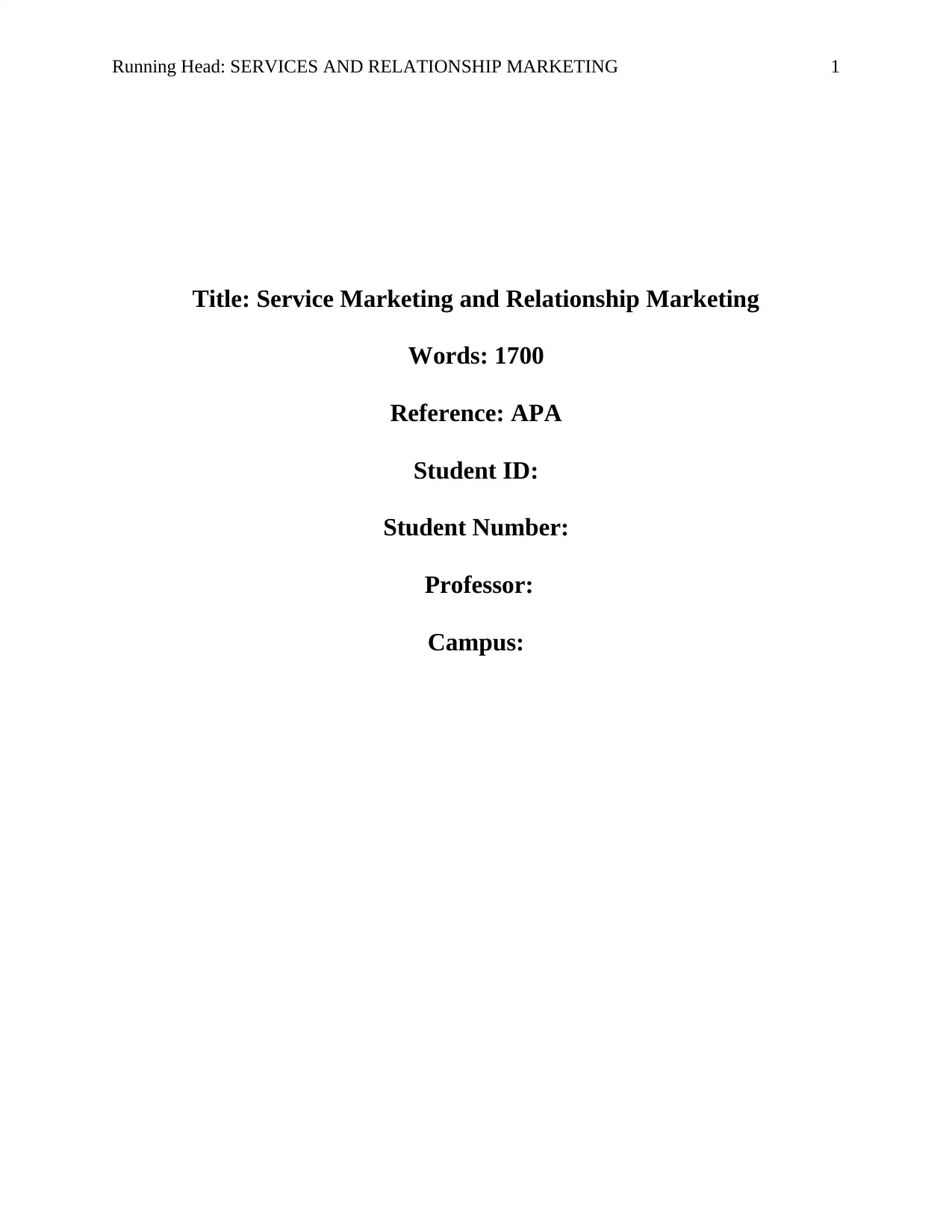
Running Head: SERVICES AND RELATIONSHIP MARKETING 1
Title: Service Marketing and Relationship Marketing
Words: 1700
Reference: APA
Student ID:
Student Number:
Professor:
Campus:
Title: Service Marketing and Relationship Marketing
Words: 1700
Reference: APA
Student ID:
Student Number:
Professor:
Campus:
Paraphrase This Document
Need a fresh take? Get an instant paraphrase of this document with our AI Paraphraser
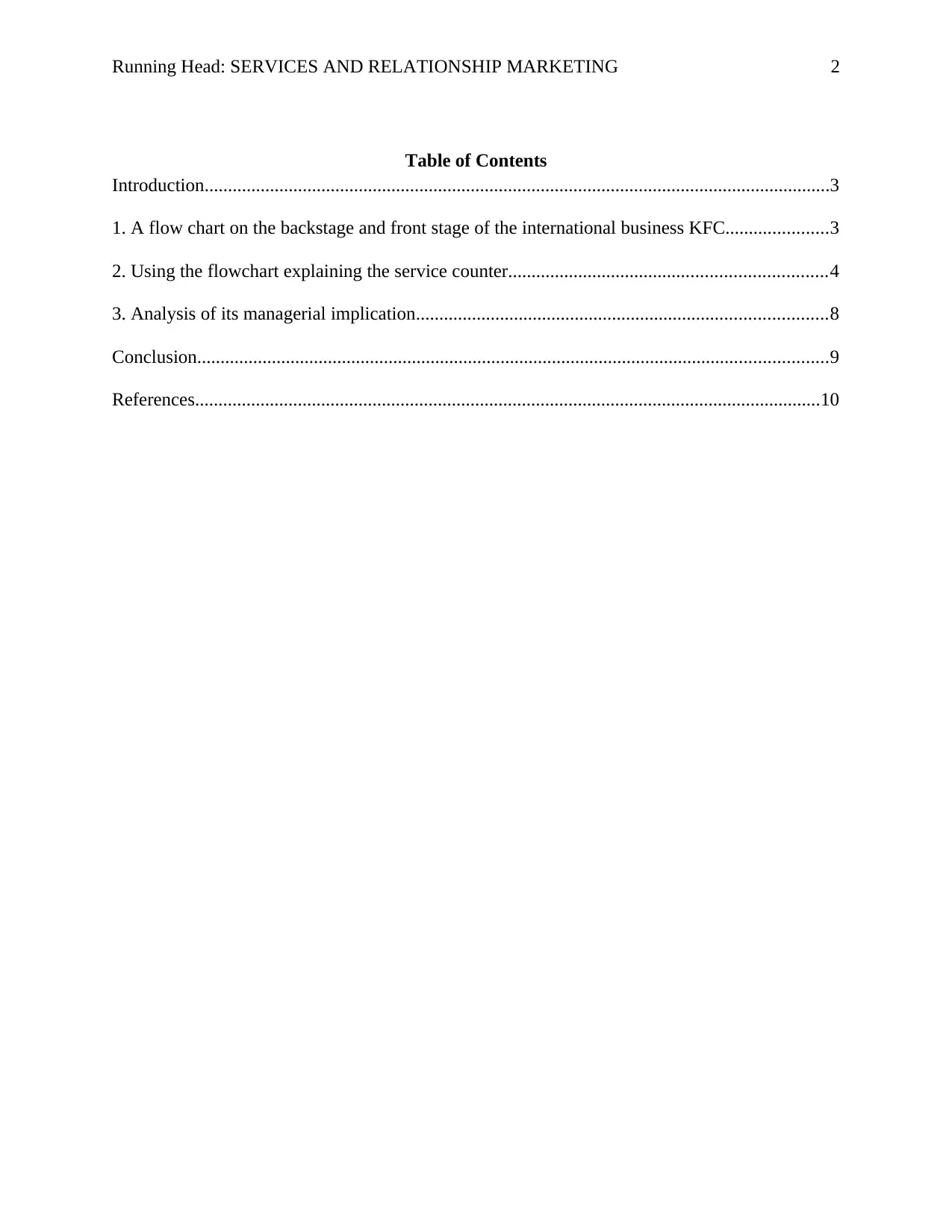
Running Head: SERVICES AND RELATIONSHIP MARKETING 2
Table of Contents
Introduction......................................................................................................................................3
1. A flow chart on the backstage and front stage of the international business KFC......................3
2. Using the flowchart explaining the service counter....................................................................4
3. Analysis of its managerial implication........................................................................................8
Conclusion.......................................................................................................................................9
References......................................................................................................................................10
Table of Contents
Introduction......................................................................................................................................3
1. A flow chart on the backstage and front stage of the international business KFC......................3
2. Using the flowchart explaining the service counter....................................................................4
3. Analysis of its managerial implication........................................................................................8
Conclusion.......................................................................................................................................9
References......................................................................................................................................10
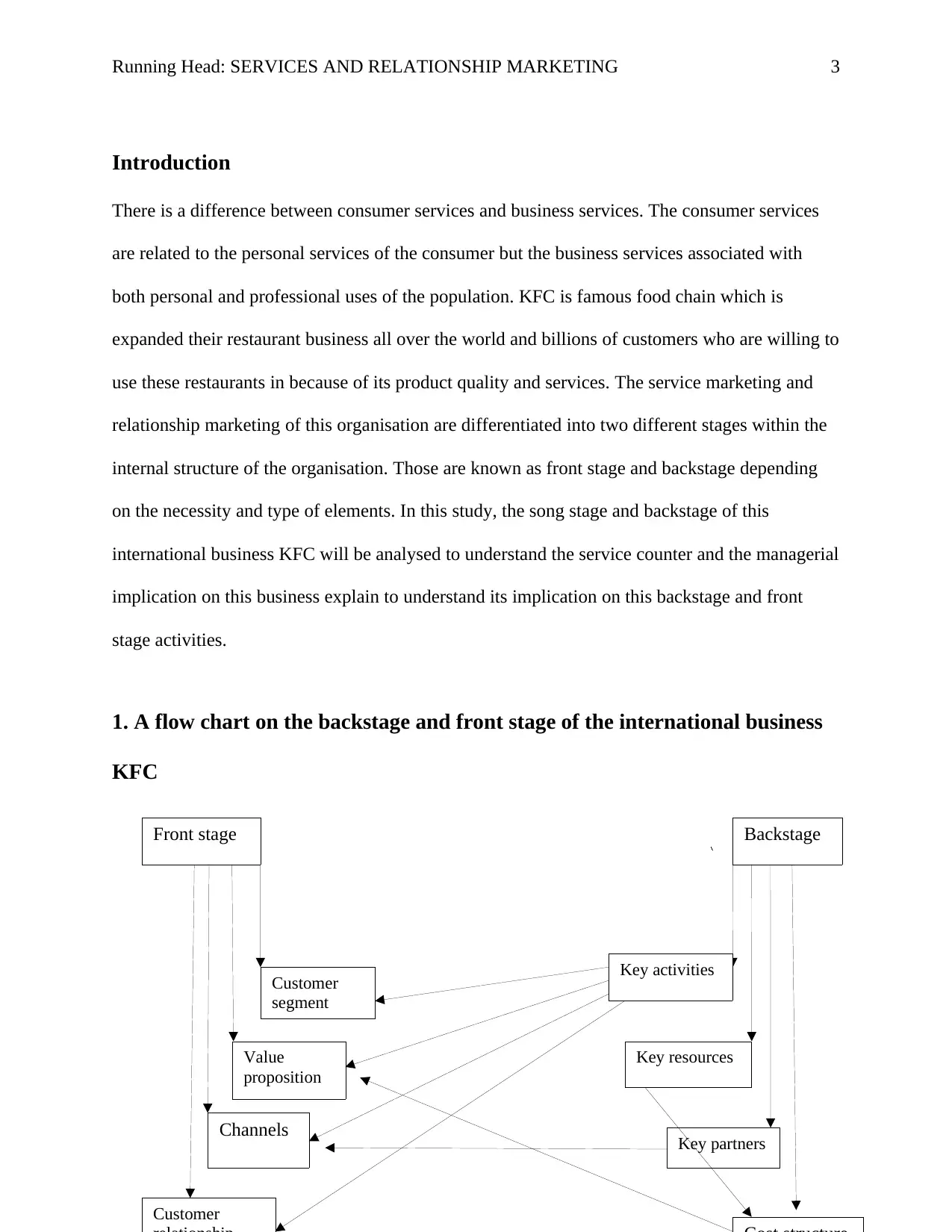
Running Head: SERVICES AND RELATIONSHIP MARKETING 3
Introduction
There is a difference between consumer services and business services. The consumer services
are related to the personal services of the consumer but the business services associated with
both personal and professional uses of the population. KFC is famous food chain which is
expanded their restaurant business all over the world and billions of customers who are willing to
use these restaurants in because of its product quality and services. The service marketing and
relationship marketing of this organisation are differentiated into two different stages within the
internal structure of the organisation. Those are known as front stage and backstage depending
on the necessity and type of elements. In this study, the song stage and backstage of this
international business KFC will be analysed to understand the service counter and the managerial
implication on this business explain to understand its implication on this backstage and front
stage activities.
1. A flow chart on the backstage and front stage of the international business
KFC
Front stage Backstage
Key partners
Key resources
Key activities
Customer
Channels
Value
proposition
Customer
segment
Introduction
There is a difference between consumer services and business services. The consumer services
are related to the personal services of the consumer but the business services associated with
both personal and professional uses of the population. KFC is famous food chain which is
expanded their restaurant business all over the world and billions of customers who are willing to
use these restaurants in because of its product quality and services. The service marketing and
relationship marketing of this organisation are differentiated into two different stages within the
internal structure of the organisation. Those are known as front stage and backstage depending
on the necessity and type of elements. In this study, the song stage and backstage of this
international business KFC will be analysed to understand the service counter and the managerial
implication on this business explain to understand its implication on this backstage and front
stage activities.
1. A flow chart on the backstage and front stage of the international business
KFC
Front stage Backstage
Key partners
Key resources
Key activities
Customer
Channels
Value
proposition
Customer
segment
⊘ This is a preview!⊘
Do you want full access?
Subscribe today to unlock all pages.

Trusted by 1+ million students worldwide
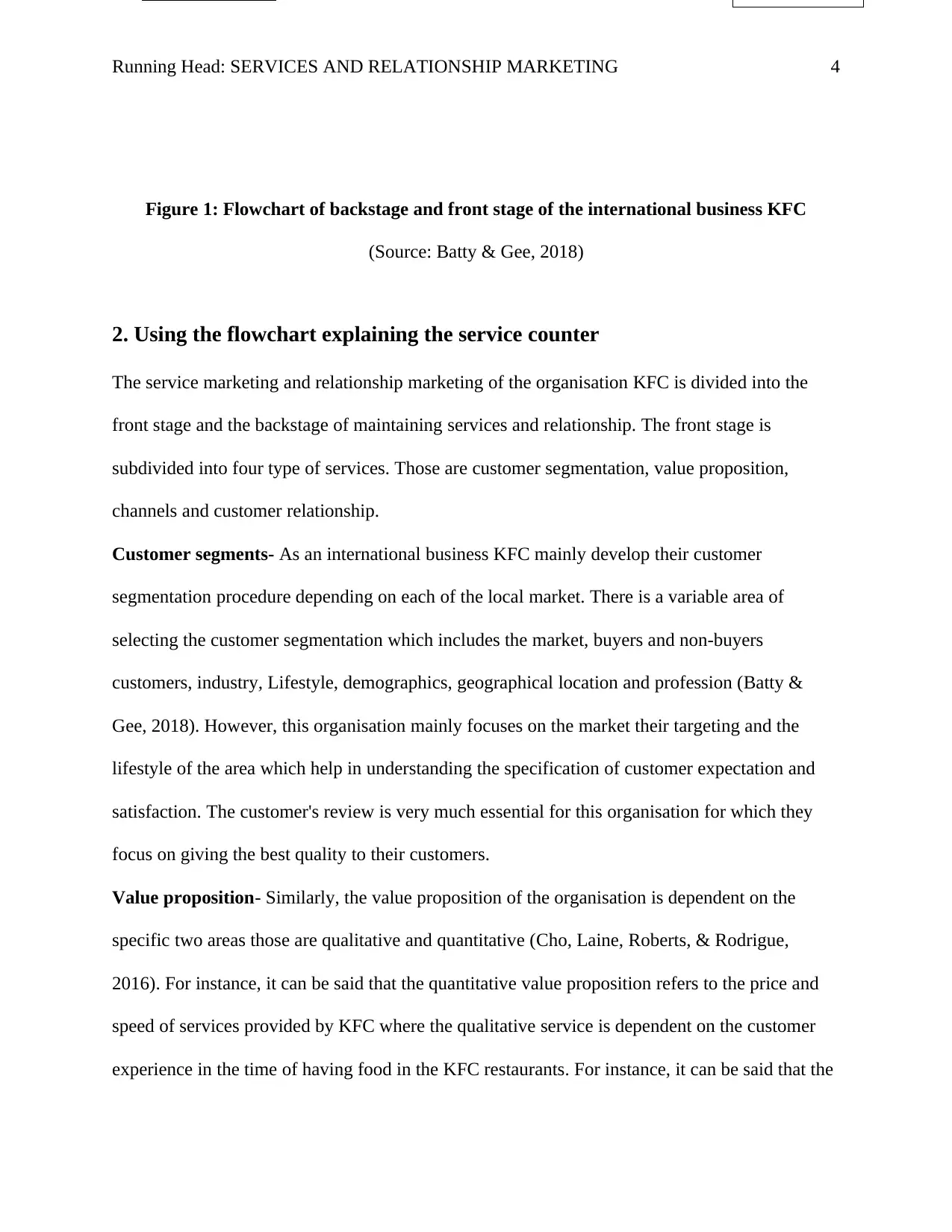
Running Head: SERVICES AND RELATIONSHIP MARKETING 4
Figure 1: Flowchart of backstage and front stage of the international business KFC
(Source: Batty & Gee, 2018)
2. Using the flowchart explaining the service counter
The service marketing and relationship marketing of the organisation KFC is divided into the
front stage and the backstage of maintaining services and relationship. The front stage is
subdivided into four type of services. Those are customer segmentation, value proposition,
channels and customer relationship.
Customer segments- As an international business KFC mainly develop their customer
segmentation procedure depending on each of the local market. There is a variable area of
selecting the customer segmentation which includes the market, buyers and non-buyers
customers, industry, Lifestyle, demographics, geographical location and profession (Batty &
Gee, 2018). However, this organisation mainly focuses on the market their targeting and the
lifestyle of the area which help in understanding the specification of customer expectation and
satisfaction. The customer's review is very much essential for this organisation for which they
focus on giving the best quality to their customers.
Value proposition- Similarly, the value proposition of the organisation is dependent on the
specific two areas those are qualitative and quantitative (Cho, Laine, Roberts, & Rodrigue,
2016). For instance, it can be said that the quantitative value proposition refers to the price and
speed of services provided by KFC where the qualitative service is dependent on the customer
experience in the time of having food in the KFC restaurants. For instance, it can be said that the
Figure 1: Flowchart of backstage and front stage of the international business KFC
(Source: Batty & Gee, 2018)
2. Using the flowchart explaining the service counter
The service marketing and relationship marketing of the organisation KFC is divided into the
front stage and the backstage of maintaining services and relationship. The front stage is
subdivided into four type of services. Those are customer segmentation, value proposition,
channels and customer relationship.
Customer segments- As an international business KFC mainly develop their customer
segmentation procedure depending on each of the local market. There is a variable area of
selecting the customer segmentation which includes the market, buyers and non-buyers
customers, industry, Lifestyle, demographics, geographical location and profession (Batty &
Gee, 2018). However, this organisation mainly focuses on the market their targeting and the
lifestyle of the area which help in understanding the specification of customer expectation and
satisfaction. The customer's review is very much essential for this organisation for which they
focus on giving the best quality to their customers.
Value proposition- Similarly, the value proposition of the organisation is dependent on the
specific two areas those are qualitative and quantitative (Cho, Laine, Roberts, & Rodrigue,
2016). For instance, it can be said that the quantitative value proposition refers to the price and
speed of services provided by KFC where the qualitative service is dependent on the customer
experience in the time of having food in the KFC restaurants. For instance, it can be said that the
Paraphrase This Document
Need a fresh take? Get an instant paraphrase of this document with our AI Paraphraser
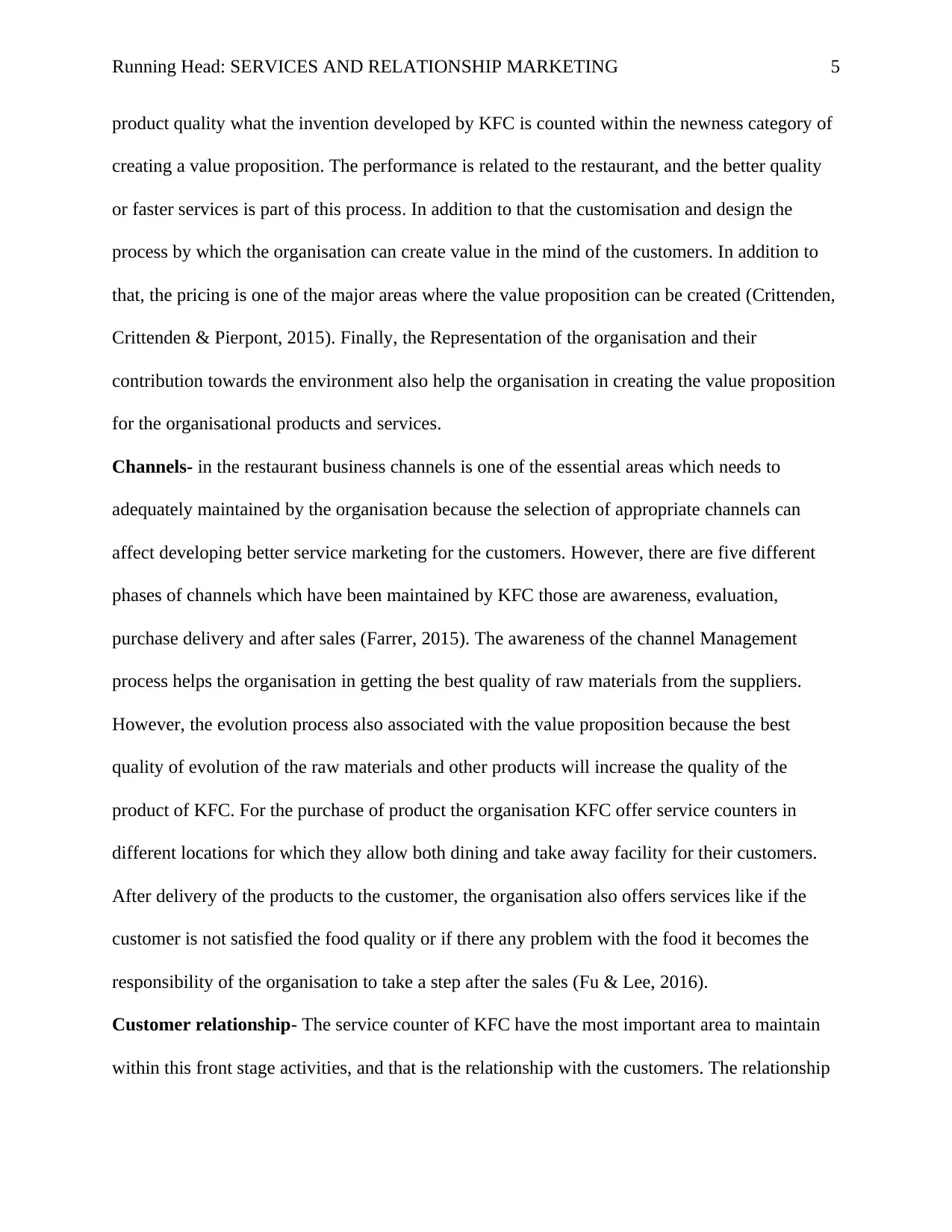
Running Head: SERVICES AND RELATIONSHIP MARKETING 5
product quality what the invention developed by KFC is counted within the newness category of
creating a value proposition. The performance is related to the restaurant, and the better quality
or faster services is part of this process. In addition to that the customisation and design the
process by which the organisation can create value in the mind of the customers. In addition to
that, the pricing is one of the major areas where the value proposition can be created (Crittenden,
Crittenden & Pierpont, 2015). Finally, the Representation of the organisation and their
contribution towards the environment also help the organisation in creating the value proposition
for the organisational products and services.
Channels- in the restaurant business channels is one of the essential areas which needs to
adequately maintained by the organisation because the selection of appropriate channels can
affect developing better service marketing for the customers. However, there are five different
phases of channels which have been maintained by KFC those are awareness, evaluation,
purchase delivery and after sales (Farrer, 2015). The awareness of the channel Management
process helps the organisation in getting the best quality of raw materials from the suppliers.
However, the evolution process also associated with the value proposition because the best
quality of evolution of the raw materials and other products will increase the quality of the
product of KFC. For the purchase of product the organisation KFC offer service counters in
different locations for which they allow both dining and take away facility for their customers.
After delivery of the products to the customer, the organisation also offers services like if the
customer is not satisfied the food quality or if there any problem with the food it becomes the
responsibility of the organisation to take a step after the sales (Fu & Lee, 2016).
Customer relationship- The service counter of KFC have the most important area to maintain
within this front stage activities, and that is the relationship with the customers. The relationship
product quality what the invention developed by KFC is counted within the newness category of
creating a value proposition. The performance is related to the restaurant, and the better quality
or faster services is part of this process. In addition to that the customisation and design the
process by which the organisation can create value in the mind of the customers. In addition to
that, the pricing is one of the major areas where the value proposition can be created (Crittenden,
Crittenden & Pierpont, 2015). Finally, the Representation of the organisation and their
contribution towards the environment also help the organisation in creating the value proposition
for the organisational products and services.
Channels- in the restaurant business channels is one of the essential areas which needs to
adequately maintained by the organisation because the selection of appropriate channels can
affect developing better service marketing for the customers. However, there are five different
phases of channels which have been maintained by KFC those are awareness, evaluation,
purchase delivery and after sales (Farrer, 2015). The awareness of the channel Management
process helps the organisation in getting the best quality of raw materials from the suppliers.
However, the evolution process also associated with the value proposition because the best
quality of evolution of the raw materials and other products will increase the quality of the
product of KFC. For the purchase of product the organisation KFC offer service counters in
different locations for which they allow both dining and take away facility for their customers.
After delivery of the products to the customer, the organisation also offers services like if the
customer is not satisfied the food quality or if there any problem with the food it becomes the
responsibility of the organisation to take a step after the sales (Fu & Lee, 2016).
Customer relationship- The service counter of KFC have the most important area to maintain
within this front stage activities, and that is the relationship with the customers. The relationship
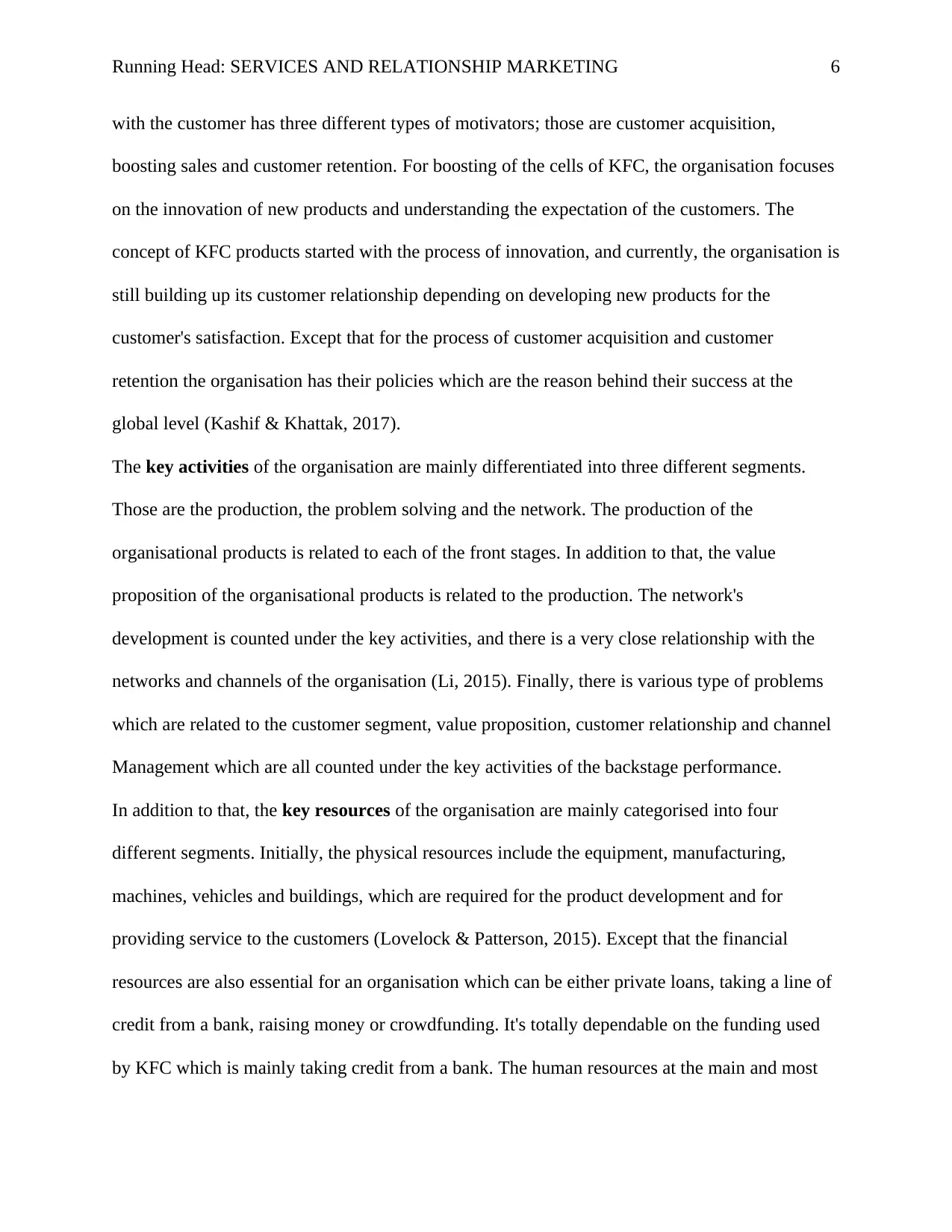
Running Head: SERVICES AND RELATIONSHIP MARKETING 6
with the customer has three different types of motivators; those are customer acquisition,
boosting sales and customer retention. For boosting of the cells of KFC, the organisation focuses
on the innovation of new products and understanding the expectation of the customers. The
concept of KFC products started with the process of innovation, and currently, the organisation is
still building up its customer relationship depending on developing new products for the
customer's satisfaction. Except that for the process of customer acquisition and customer
retention the organisation has their policies which are the reason behind their success at the
global level (Kashif & Khattak, 2017).
The key activities of the organisation are mainly differentiated into three different segments.
Those are the production, the problem solving and the network. The production of the
organisational products is related to each of the front stages. In addition to that, the value
proposition of the organisational products is related to the production. The network's
development is counted under the key activities, and there is a very close relationship with the
networks and channels of the organisation (Li, 2015). Finally, there is various type of problems
which are related to the customer segment, value proposition, customer relationship and channel
Management which are all counted under the key activities of the backstage performance.
In addition to that, the key resources of the organisation are mainly categorised into four
different segments. Initially, the physical resources include the equipment, manufacturing,
machines, vehicles and buildings, which are required for the product development and for
providing service to the customers (Lovelock & Patterson, 2015). Except that the financial
resources are also essential for an organisation which can be either private loans, taking a line of
credit from a bank, raising money or crowdfunding. It's totally dependable on the funding used
by KFC which is mainly taking credit from a bank. The human resources at the main and most
with the customer has three different types of motivators; those are customer acquisition,
boosting sales and customer retention. For boosting of the cells of KFC, the organisation focuses
on the innovation of new products and understanding the expectation of the customers. The
concept of KFC products started with the process of innovation, and currently, the organisation is
still building up its customer relationship depending on developing new products for the
customer's satisfaction. Except that for the process of customer acquisition and customer
retention the organisation has their policies which are the reason behind their success at the
global level (Kashif & Khattak, 2017).
The key activities of the organisation are mainly differentiated into three different segments.
Those are the production, the problem solving and the network. The production of the
organisational products is related to each of the front stages. In addition to that, the value
proposition of the organisational products is related to the production. The network's
development is counted under the key activities, and there is a very close relationship with the
networks and channels of the organisation (Li, 2015). Finally, there is various type of problems
which are related to the customer segment, value proposition, customer relationship and channel
Management which are all counted under the key activities of the backstage performance.
In addition to that, the key resources of the organisation are mainly categorised into four
different segments. Initially, the physical resources include the equipment, manufacturing,
machines, vehicles and buildings, which are required for the product development and for
providing service to the customers (Lovelock & Patterson, 2015). Except that the financial
resources are also essential for an organisation which can be either private loans, taking a line of
credit from a bank, raising money or crowdfunding. It's totally dependable on the funding used
by KFC which is mainly taking credit from a bank. The human resources at the main and most
⊘ This is a preview!⊘
Do you want full access?
Subscribe today to unlock all pages.

Trusted by 1+ million students worldwide
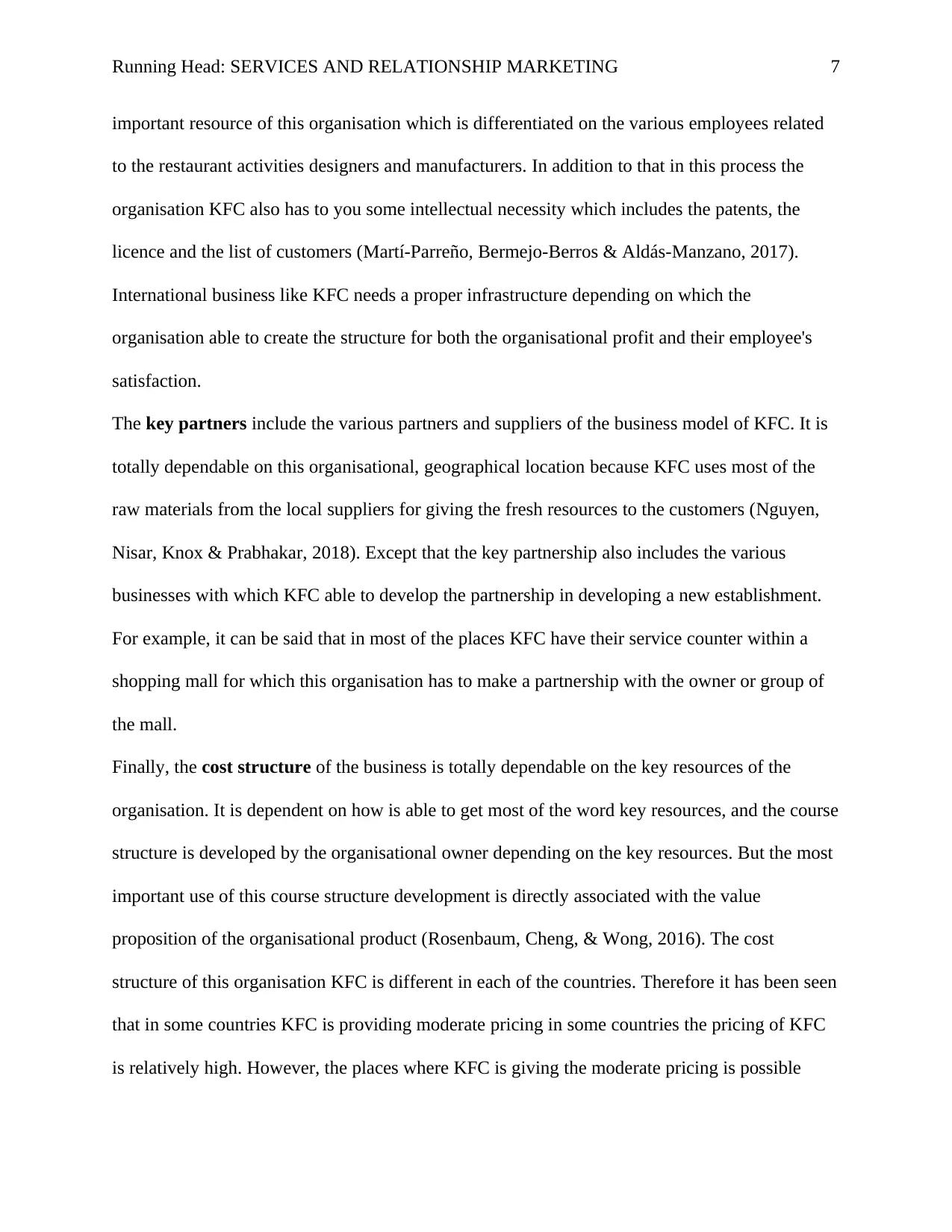
Running Head: SERVICES AND RELATIONSHIP MARKETING 7
important resource of this organisation which is differentiated on the various employees related
to the restaurant activities designers and manufacturers. In addition to that in this process the
organisation KFC also has to you some intellectual necessity which includes the patents, the
licence and the list of customers (Martí-Parreño, Bermejo-Berros & Aldás-Manzano, 2017).
International business like KFC needs a proper infrastructure depending on which the
organisation able to create the structure for both the organisational profit and their employee's
satisfaction.
The key partners include the various partners and suppliers of the business model of KFC. It is
totally dependable on this organisational, geographical location because KFC uses most of the
raw materials from the local suppliers for giving the fresh resources to the customers (Nguyen,
Nisar, Knox & Prabhakar, 2018). Except that the key partnership also includes the various
businesses with which KFC able to develop the partnership in developing a new establishment.
For example, it can be said that in most of the places KFC have their service counter within a
shopping mall for which this organisation has to make a partnership with the owner or group of
the mall.
Finally, the cost structure of the business is totally dependable on the key resources of the
organisation. It is dependent on how is able to get most of the word key resources, and the course
structure is developed by the organisational owner depending on the key resources. But the most
important use of this course structure development is directly associated with the value
proposition of the organisational product (Rosenbaum, Cheng, & Wong, 2016). The cost
structure of this organisation KFC is different in each of the countries. Therefore it has been seen
that in some countries KFC is providing moderate pricing in some countries the pricing of KFC
is relatively high. However, the places where KFC is giving the moderate pricing is possible
important resource of this organisation which is differentiated on the various employees related
to the restaurant activities designers and manufacturers. In addition to that in this process the
organisation KFC also has to you some intellectual necessity which includes the patents, the
licence and the list of customers (Martí-Parreño, Bermejo-Berros & Aldás-Manzano, 2017).
International business like KFC needs a proper infrastructure depending on which the
organisation able to create the structure for both the organisational profit and their employee's
satisfaction.
The key partners include the various partners and suppliers of the business model of KFC. It is
totally dependable on this organisational, geographical location because KFC uses most of the
raw materials from the local suppliers for giving the fresh resources to the customers (Nguyen,
Nisar, Knox & Prabhakar, 2018). Except that the key partnership also includes the various
businesses with which KFC able to develop the partnership in developing a new establishment.
For example, it can be said that in most of the places KFC have their service counter within a
shopping mall for which this organisation has to make a partnership with the owner or group of
the mall.
Finally, the cost structure of the business is totally dependable on the key resources of the
organisation. It is dependent on how is able to get most of the word key resources, and the course
structure is developed by the organisational owner depending on the key resources. But the most
important use of this course structure development is directly associated with the value
proposition of the organisational product (Rosenbaum, Cheng, & Wong, 2016). The cost
structure of this organisation KFC is different in each of the countries. Therefore it has been seen
that in some countries KFC is providing moderate pricing in some countries the pricing of KFC
is relatively high. However, the places where KFC is giving the moderate pricing is possible
Paraphrase This Document
Need a fresh take? Get an instant paraphrase of this document with our AI Paraphraser

Running Head: SERVICES AND RELATIONSHIP MARKETING 8
because of the key resources used in this countries are easily available. However, for the creation
of value proposition which is a front page of the organisation this backstage element is very
much effective (Tan, Oriade & Fallon, 2014).
3. Analysis of its managerial implication
In analysing the managerial implication of this organisation KFC it has to understand that the
intangible elements usually dominate the value creation. KFC is associated with and developing
innovative products for the customers which directly affect on the customers to get attracted, and
also the competitiveness of the product decreases and the distinguished character of KFC get
revealed in front of the customers. However, it has been seen that the initiatives of KFC provide
their customers with an opportunity to visit the kitchen and understand the procedure of
producing KFC fried chicken (Wu & Cheng, 2018). This process is very helpful because the
customer interaction with the employee's increases during this process and the facilities and
Systems within this organisation can easily visible to the customers.
In addition to that, when the customers able to experience the services of KFC they will
understand the appearance behaviour and attitude of the service. This process is not only helpful
for developing a value proposition for these organisational products but also give and a different
shape on the customer's experience and satisfaction level. In addition to that, for this process,
KFC has to give proper training to the employees from which they can easily entertain their
customers, and they will be able to shape the behaviour of the customers. In addition to that, the
time factor assumes great importance for the managerial area. And it also directly associated
with developing the number of customers. An in time service for the customer will be spent
wisely by the organisation (Rosenbaum, Cheng & Wong, 2016). The wasting of time is totally
because of the key resources used in this countries are easily available. However, for the creation
of value proposition which is a front page of the organisation this backstage element is very
much effective (Tan, Oriade & Fallon, 2014).
3. Analysis of its managerial implication
In analysing the managerial implication of this organisation KFC it has to understand that the
intangible elements usually dominate the value creation. KFC is associated with and developing
innovative products for the customers which directly affect on the customers to get attracted, and
also the competitiveness of the product decreases and the distinguished character of KFC get
revealed in front of the customers. However, it has been seen that the initiatives of KFC provide
their customers with an opportunity to visit the kitchen and understand the procedure of
producing KFC fried chicken (Wu & Cheng, 2018). This process is very helpful because the
customer interaction with the employee's increases during this process and the facilities and
Systems within this organisation can easily visible to the customers.
In addition to that, when the customers able to experience the services of KFC they will
understand the appearance behaviour and attitude of the service. This process is not only helpful
for developing a value proposition for these organisational products but also give and a different
shape on the customer's experience and satisfaction level. In addition to that, for this process,
KFC has to give proper training to the employees from which they can easily entertain their
customers, and they will be able to shape the behaviour of the customers. In addition to that, the
time factor assumes great importance for the managerial area. And it also directly associated
with developing the number of customers. An in time service for the customer will be spent
wisely by the organisation (Rosenbaum, Cheng & Wong, 2016). The wasting of time is totally

Running Head: SERVICES AND RELATIONSHIP MARKETING 9
disliked by most of the customers, and therefore the customers want fast, and Quality Services
from the organisation like KFC. for a meeting this agenda the employees of the organisation and
organisational working structure has developed with providing instant food for the customers and
this process helps the organisation in extending the service hours.
Conclusion
In light of the above discussion, it can be concluded that the backstage and front stage activities
of KFC are complicated because of its huge structure and global appearance. The consumer
services are relatively different from the business services, but the appropriate usage of
managerial implications can develop the services faster than the business services provided in all
over the world.
disliked by most of the customers, and therefore the customers want fast, and Quality Services
from the organisation like KFC. for a meeting this agenda the employees of the organisation and
organisational working structure has developed with providing instant food for the customers and
this process helps the organisation in extending the service hours.
Conclusion
In light of the above discussion, it can be concluded that the backstage and front stage activities
of KFC are complicated because of its huge structure and global appearance. The consumer
services are relatively different from the business services, but the appropriate usage of
managerial implications can develop the services faster than the business services provided in all
over the world.
⊘ This is a preview!⊘
Do you want full access?
Subscribe today to unlock all pages.

Trusted by 1+ million students worldwide
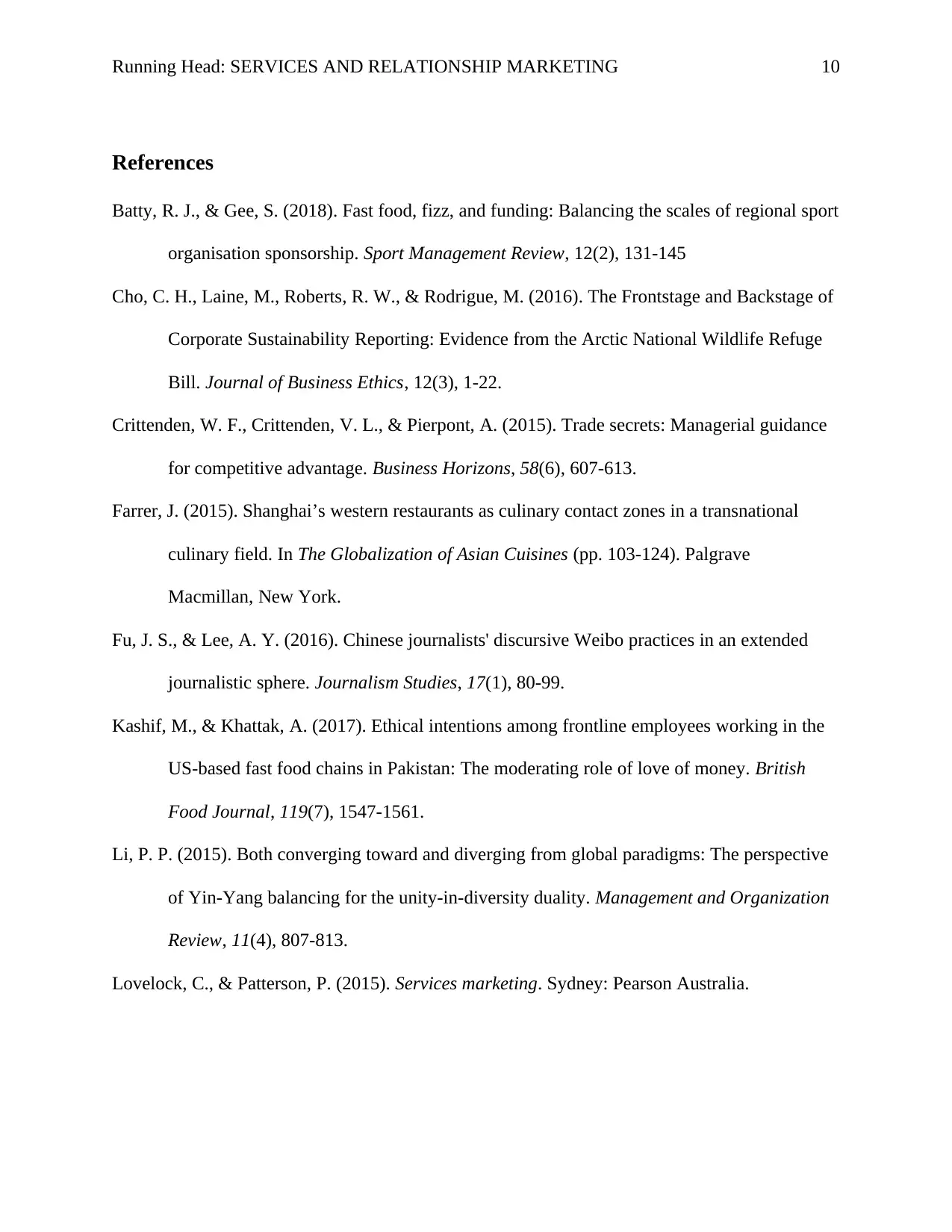
Running Head: SERVICES AND RELATIONSHIP MARKETING 10
References
Batty, R. J., & Gee, S. (2018). Fast food, fizz, and funding: Balancing the scales of regional sport
organisation sponsorship. Sport Management Review, 12(2), 131-145
Cho, C. H., Laine, M., Roberts, R. W., & Rodrigue, M. (2016). The Frontstage and Backstage of
Corporate Sustainability Reporting: Evidence from the Arctic National Wildlife Refuge
Bill. Journal of Business Ethics, 12(3), 1-22.
Crittenden, W. F., Crittenden, V. L., & Pierpont, A. (2015). Trade secrets: Managerial guidance
for competitive advantage. Business Horizons, 58(6), 607-613.
Farrer, J. (2015). Shanghai’s western restaurants as culinary contact zones in a transnational
culinary field. In The Globalization of Asian Cuisines (pp. 103-124). Palgrave
Macmillan, New York.
Fu, J. S., & Lee, A. Y. (2016). Chinese journalists' discursive Weibo practices in an extended
journalistic sphere. Journalism Studies, 17(1), 80-99.
Kashif, M., & Khattak, A. (2017). Ethical intentions among frontline employees working in the
US-based fast food chains in Pakistan: The moderating role of love of money. British
Food Journal, 119(7), 1547-1561.
Li, P. P. (2015). Both converging toward and diverging from global paradigms: The perspective
of Yin-Yang balancing for the unity-in-diversity duality. Management and Organization
Review, 11(4), 807-813.
Lovelock, C., & Patterson, P. (2015). Services marketing. Sydney: Pearson Australia.
References
Batty, R. J., & Gee, S. (2018). Fast food, fizz, and funding: Balancing the scales of regional sport
organisation sponsorship. Sport Management Review, 12(2), 131-145
Cho, C. H., Laine, M., Roberts, R. W., & Rodrigue, M. (2016). The Frontstage and Backstage of
Corporate Sustainability Reporting: Evidence from the Arctic National Wildlife Refuge
Bill. Journal of Business Ethics, 12(3), 1-22.
Crittenden, W. F., Crittenden, V. L., & Pierpont, A. (2015). Trade secrets: Managerial guidance
for competitive advantage. Business Horizons, 58(6), 607-613.
Farrer, J. (2015). Shanghai’s western restaurants as culinary contact zones in a transnational
culinary field. In The Globalization of Asian Cuisines (pp. 103-124). Palgrave
Macmillan, New York.
Fu, J. S., & Lee, A. Y. (2016). Chinese journalists' discursive Weibo practices in an extended
journalistic sphere. Journalism Studies, 17(1), 80-99.
Kashif, M., & Khattak, A. (2017). Ethical intentions among frontline employees working in the
US-based fast food chains in Pakistan: The moderating role of love of money. British
Food Journal, 119(7), 1547-1561.
Li, P. P. (2015). Both converging toward and diverging from global paradigms: The perspective
of Yin-Yang balancing for the unity-in-diversity duality. Management and Organization
Review, 11(4), 807-813.
Lovelock, C., & Patterson, P. (2015). Services marketing. Sydney: Pearson Australia.
Paraphrase This Document
Need a fresh take? Get an instant paraphrase of this document with our AI Paraphraser
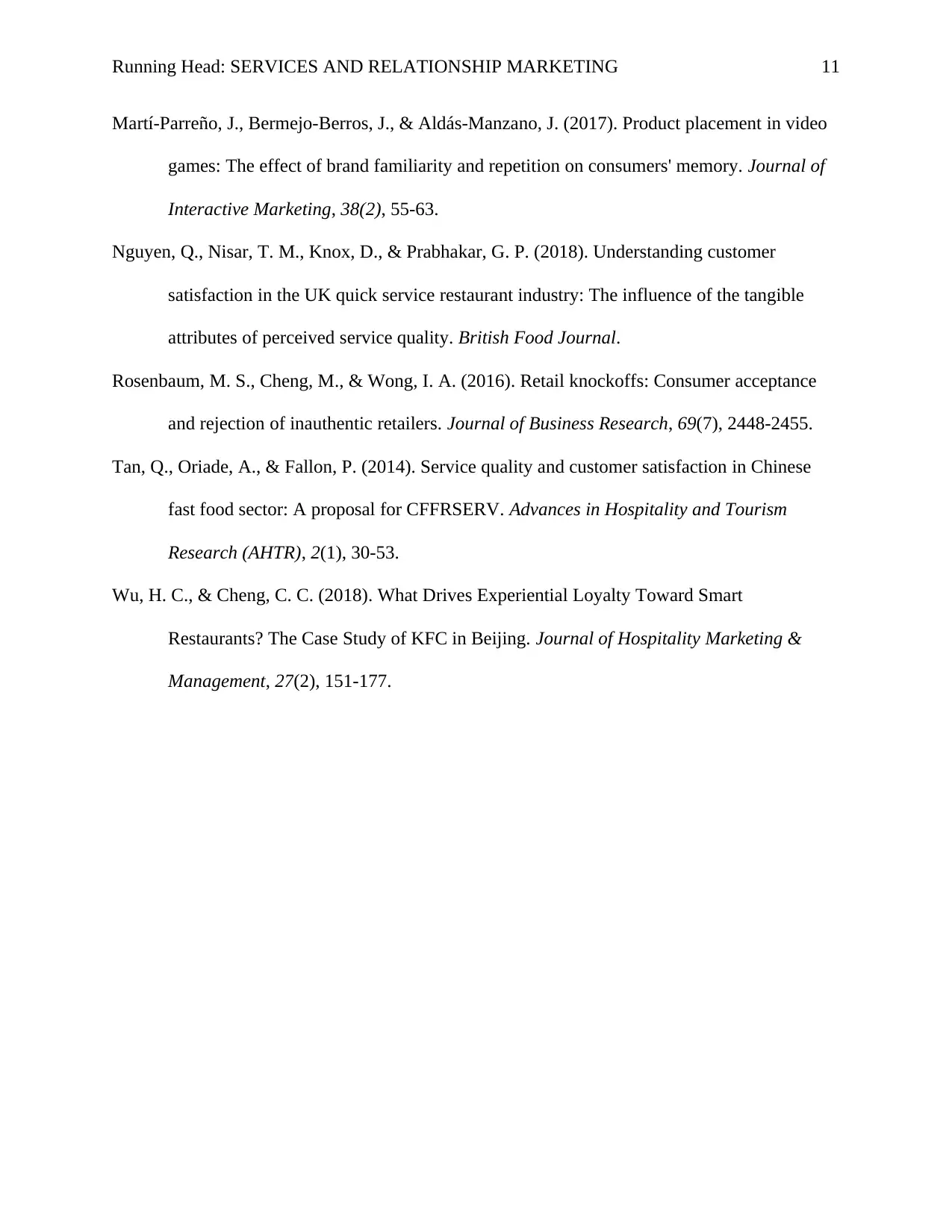
Running Head: SERVICES AND RELATIONSHIP MARKETING 11
Martí-Parreño, J., Bermejo-Berros, J., & Aldás-Manzano, J. (2017). Product placement in video
games: The effect of brand familiarity and repetition on consumers' memory. Journal of
Interactive Marketing, 38(2), 55-63.
Nguyen, Q., Nisar, T. M., Knox, D., & Prabhakar, G. P. (2018). Understanding customer
satisfaction in the UK quick service restaurant industry: The influence of the tangible
attributes of perceived service quality. British Food Journal.
Rosenbaum, M. S., Cheng, M., & Wong, I. A. (2016). Retail knockoffs: Consumer acceptance
and rejection of inauthentic retailers. Journal of Business Research, 69(7), 2448-2455.
Tan, Q., Oriade, A., & Fallon, P. (2014). Service quality and customer satisfaction in Chinese
fast food sector: A proposal for CFFRSERV. Advances in Hospitality and Tourism
Research (AHTR), 2(1), 30-53.
Wu, H. C., & Cheng, C. C. (2018). What Drives Experiential Loyalty Toward Smart
Restaurants? The Case Study of KFC in Beijing. Journal of Hospitality Marketing &
Management, 27(2), 151-177.
Martí-Parreño, J., Bermejo-Berros, J., & Aldás-Manzano, J. (2017). Product placement in video
games: The effect of brand familiarity and repetition on consumers' memory. Journal of
Interactive Marketing, 38(2), 55-63.
Nguyen, Q., Nisar, T. M., Knox, D., & Prabhakar, G. P. (2018). Understanding customer
satisfaction in the UK quick service restaurant industry: The influence of the tangible
attributes of perceived service quality. British Food Journal.
Rosenbaum, M. S., Cheng, M., & Wong, I. A. (2016). Retail knockoffs: Consumer acceptance
and rejection of inauthentic retailers. Journal of Business Research, 69(7), 2448-2455.
Tan, Q., Oriade, A., & Fallon, P. (2014). Service quality and customer satisfaction in Chinese
fast food sector: A proposal for CFFRSERV. Advances in Hospitality and Tourism
Research (AHTR), 2(1), 30-53.
Wu, H. C., & Cheng, C. C. (2018). What Drives Experiential Loyalty Toward Smart
Restaurants? The Case Study of KFC in Beijing. Journal of Hospitality Marketing &
Management, 27(2), 151-177.
1 out of 11
Related Documents
Your All-in-One AI-Powered Toolkit for Academic Success.
+13062052269
info@desklib.com
Available 24*7 on WhatsApp / Email
![[object Object]](/_next/static/media/star-bottom.7253800d.svg)
Unlock your academic potential
Copyright © 2020–2025 A2Z Services. All Rights Reserved. Developed and managed by ZUCOL.





